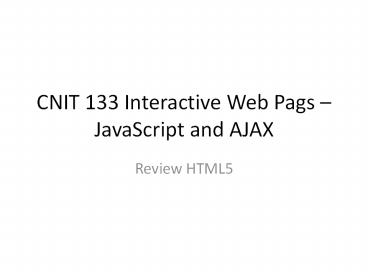CNIT 133 Interactive Web Pags PowerPoint PPT Presentation
Title: CNIT 133 Interactive Web Pags
1
CNIT 133 Interactive Web Pags JavaScript and
AJAX
- Review HTML5
2
Agenda
- My Web Site http//fog.ccsf.edu/hyip (download
syllabus, class notes). - HTML
- XHTML
3
HTML
- A Web page is simply a text file written in a
language called Hypertext Markup Language (HTML). - Markup Language is a language that describes a
documents structure and content. - Hypertext Markup Language (HTML) a
nonproprietary markup language that a Web browser
interprets and uses to display the content as a
Web page. - A group of Web developers, programmers, and
authors formed the World Wide Web Consortium or
the W3C. (http//www.w3c.org) - The World Wide Web Consortium (W3C) developed
specifications, or sets of standards, that
identify how a browser interprets the HTML code.
4
HTML5
- HTML has been in continuous evolution since it
was introduced to the Internet in the early
1990s. Some features were introduced in
specifications others were introduced in
software releases. In some respects,
implementations and Web developer practices have
converged with each other and with specifications
and standards, but in other ways, they have
diverged. - HTML4 became a W3C Recommendation in 1997. While
it continues to serve as a rough guide to many of
the core features of HTML, it does not provide
enough information to build implementations that
interoperate with each other and, more
importantly, with Web content. The same goes for
XHTML1, which defines an XML serialization for
HTML4, and DOM Level 2 HTML, which defines
JavaScript APIs for both HTML and XHTML. HTML5
replaces DOM2HTML, HTML4, and XHTML1.
5
HTML specification
- The HTML (AKA HTML5) specification reflects an
effort, started in 2004, to study contemporary
HTML implementations and Web content. The
specification - Defines a single language called HTML which can
be written in HTML syntax and in XML syntax. - Defines detailed processing models to foster
interoperable implementations. - Improves markup for documents.
- Introduces markup and APIs for emerging idioms,
such as Web applications.
6
HTML Syntax
- HTML (or AKA HTML5) defines a syntax, referred to
as "the HTML syntax", that is mostly compatible
with HTML4 and XHTML1 documents published on the
Web, but is not compatible with the more esoteric
SGML features of HTML4. Documents using the HTML
syntax are served with the text/html media type. - HTML also defines detailed parsing rules
(including "error handling") for this syntax
which are largely compatible with HTML4-era
implementations. User agents have to use these
rules for resources that have the text/html media
type. Here is an example document that conforms
to the HTML syntax
7
HTML Template
- lt!DOCTYPE htmlgt
- lthtml lang"en"gt
- ltheadgt
- ltmeta charset"utf-8"gt
- lttitlegtHTML5 Templatelt/titlegt
- lt/headgt
- ltbodygt
- ltheadergt
- lth1gtHTML5 Templatelt/h1gt
- lt/headergt
- ltsectiongt
- ltpgtSection elementlt/pgt
- lt/sectiongt
- ltarticlegt
- ltpgtArticle elementlt/pgt
- lt/articlegt
- ltnavgt
- ltpgtNavigation elementlt/pgt
- lt/navgt
8
XML Syntax
- The other syntax that can be used for HTML is
XML. This syntax is compatible with XHTML1
documents and implementations. Documents using
this syntax need to be served with an XML media
type (such as application/xhtmlxml or
application/xml) and elements need to be put in
the http//www.w3.org/1999/xhtml namespace
following the rules set forth by the XML
specifications. XML XMLNS
9
XML Template
- lt?xml version"1.0" encoding"UTF-8"?gt
- lthtml xmlns"http//www.w3.org/1999/xhtml"gt
- ltheadgt lttitlegtExample documentlt/titlegt
- lt/headgt
- ltbodygt
- ltpgtExample paragraphlt/pgt
- lt/bodygt
- lt/htmlgt
10
HTML References
- http//www.w3.org/TR/html5/ (HTML5 specification)
- http//dev.w3.org/html5/html-author/ (HTML5
reference) - http//dev.w3.org/html5/markup/syntax.html(HTML5
Syntax) - http//dev.w3.org/html5/markup/elements.html
(HTML5 Language Reference) - http//www.w3.org/TR/html5-diff/(HTML5
differences from HTML4, New Elements 3.1, New
Attributes 3.2, Changed Elements 3.3, Changed
Attributes 3.4, Obsolete Elements 3.5,
Obsolete Attributes 3.6 )
11
HTML
- In a Web page, most content is marked as either
a block-level element or an inline element. - A block-level element contains content displayed
in a separate section within the page, setting it
off from other blocks. - For example,
- Paragraph ltpgt lt/pgt,
- Heading lth1..6gt lt/h1..6gt,
- Ordered List ltolgt lt/olgt,
- Unordered List ltulgt lt/ulgt
12
HTML
- An inline element is part of the same block as
its surrounding contentfor example individual
words or phrases within a paragraph. - Such as,
- Bold text ltbgt lt/bgt,
- Citation text ltcitegt lt/citegt,
- Deleted text ltdelgt lt/delgt,
- Italic text ltigt lt/igt,
- Subscript text ltsubgt lt/subgt,
- Superscript text ltsupgt lt/supgt
13
HTML Special Symbols
14
HTML Tags
- lth1gt lt/h1gt..lth6gt lth6gt
- ltpgt lt/pgt
- lta href" " target"_blank"gt lt/agt
- ltimg src"file.gif" alt"text" width"100"
height"100" /gt - ltulgt ltligt lt/ligt
- ltligt lt/ligt
- lt/ulgt
- ltolgt ltligt lt/ligt.
- ltligt lt/ligt
- lt/olgt
- lttable border"2gt
- lttrgtltthgt lt/thgtlt/trgt
- lttrgtlttdgt lt/tdgtlt/trgt
- lt/tablegt
- ltform action"dir/pgm_name.php"
method"get/post" gt - ltinput type"text/hidden/password/checkbox/radio/
button/reset/submit" value" " /gt - lttextarea rows" " cols" "gtinitial
datalt/textareagt - ltselectgtltoption value" "gtOpt namelt/optiongt.
- ltoptiongt lt/optiongt

